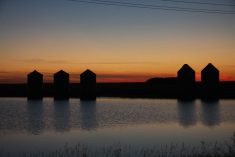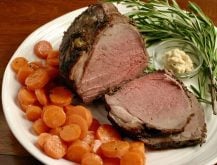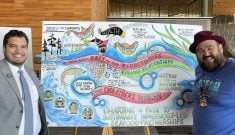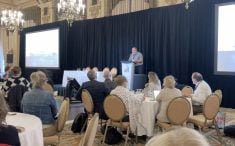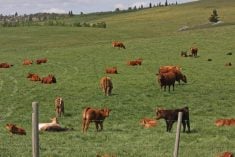VIBANK, Sask. – The peaceful setting of Lone Pine Cattle Services belies the busy lifestyle its occupants lead.
A gently rolling landscape dotted with bush and grazing beef cows suggests the bucolic life usually depicted in photographs.
This is home for 235 Hereford cows.
Rob and Dawn O’Connor live here, too, but some days it feels like just a stopping place.
Rob is the manager of the Western Canada Farm Progress Show. Dawn is a nurse in Regina General Hospital’s pediatric ward.
Read Also

Know what costs are involved in keeping crops in the bin
When you’re looking at full bins and rising calf prices, the human reflex is to hold on and hope for more. That’s not a plan. It’s a bet. Storage has a price tag.
Meshing his five-day work week with her 12-hour shifts, day care for their two-year-old daughter, Lexie, and the cows requires careful planning.
“It’s a challenge,” Rob said.
It’s especially so at this time of year, when calving season is quickly followed by final preparation for the June show.
Rob has been involved with the show in various capacities since 2001 when he was first hired to manage agricultural events at Regina’s Exhibition Park, now Ipsco Place.
Born in Ontario but raised near Kisbey, Sask., until his parents moved back east when he was 15, Rob obtained a degree in agricultural business from the University of Guelph.
The family had adopted the Lone Pine name at Kisbey and taken it east with them.
Rob maintained ties with Saskatchewan and met nursing student Dawn, from Grenfell, Sask., during the national Hereford show at Canadian Western Agribition.
They’ve been married 10 years and purchased their farm just north of Vibank seven years ago, bringing the Lone Pine name back west.
They wanted a place within commuting distance to their off-farm jobs and with good water. At the time there were a number of dairy farms on the same road.
“I knew you couldn’t have a dairy farm without good water,” Rob said.
Dawn added that a decent house and some cattle facilities to get them started were also requirements. Although the location was priced a little higher than they wanted, it was much more affordable than a move to Ontario.
“We could afford to farm out here,” she said.
They have since expanded the cattle handling facilities as their herd grew.
They offer fitting services and have seen much success in the show ring with their own animals, including the 2006 Agribition grand champion bull, Heat.
The O’Connors like to be able to offer different genetics, though.
“The bull that wins the show, everyone uses,” he said. “We try to find something just as good.”
The post-BSE world led them to another venture – Lone Pine freezer beef, which they sell at Saskatchewan farmers’ markets in White City and Montmartre and through their website.
It started with a favourite 3,000-pound arthritic bull that Rob couldn’t bear to ship but was willing to take to a butcher north of Regina. The resulting boxed burgers sold out in no time.
“Dawn is an incredible salesperson,” he said.
But the reality is that they can take an animal that might be worth $500 to ship and turn it into $1,100 by adding some value.
The market is looking strong. Dawn said demand at a local restaurant is so good that it is buying eight cases of burgers every two weeks.
They also couldn’t do it without a good relationship with their butcher. At one point they were within 12 hours of running out of inventory but he was willing to work them into a busy schedule.
Now they are branching out to include breakfast sausages, smokies and bratwurst.
“Most farmers say they don’t have the time,” Rob said, and they are content to sell larger cuts and sides. “But there’s no money in selling it at $1.60 a lb.”
They’ve done research and found a finished steer can return $2,000 to $3,000 depending on its size. More people could do it, but not all are willing to jump through the regulatory hoops, Dawn said.
The movement to eat locally or follow the 100-mile diet is good for entrepreneurs like the O’Connors.
Still, the time has come to make some decisions.
The last year has been the toughest yet, they said. BSE came and went but the increasing value of the Canadian dollar took a lot of buyers out of their market. That and the cost of feed have made things difficult for most cattle producers.
“We’re going to have a production sale this year and cut back a little bit,” Rob said.
They want to cut their debt and workload. Two years ago, Rob had resigned his position as show manager, which would have allowed more time with the cattle, but was lured back.
“Farm show is his baby,” Dawn teased.
When he first started at the park, agricultural events were losing money. Three months into his job the annual report revealed a $600,000 loss, half of it from agricultural events and the farm show.
The park-produced events started disappearing, and by 2003 only the farm show remained.
Buffalo Days no longer carried an agricultural component, horse racing had been cancelled and the park entered a time of uncertainty as far as agriculture was concerned. For two years, Rob acted as interim farm show manager and in 2005, he took on the job permanently.
“Nine years ago farm show lost money,” he said. “Regina Exhibition Association needs its produced events to generate enough revenue to sustain it for the entire year.”
Five years ago, the show generated a $300,000 profit and continues to perform well.
He said attendance has gone up even though the number of farms has declined.



